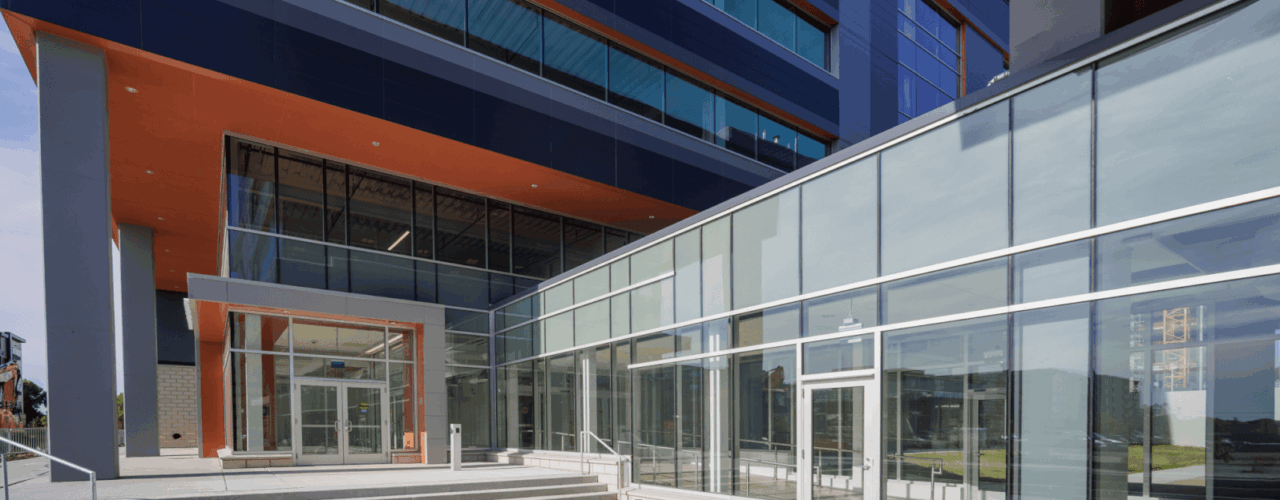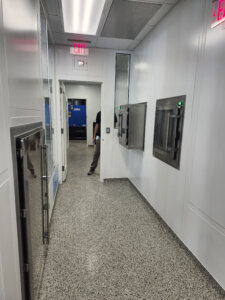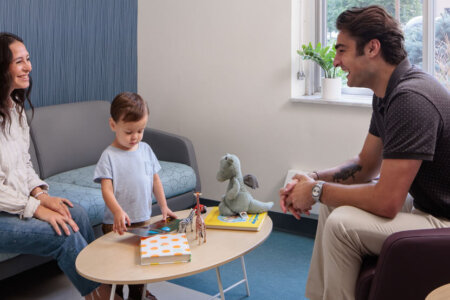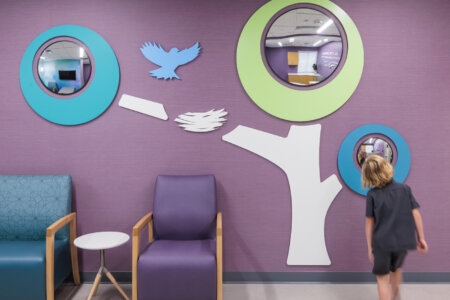Speed, Precision, and a New Standard in Radiopharmaceutical Therapy Facility Design

RSP Healthcare Design Lead Basem Hammami, explains how his team created a complex lab environment and prototype that supports groundbreaking personalized cancer treatment.
Establishing a Prototype for Mainstream Adoption
Radiopharmaceutical therapy is at a turning point. Much like Proton Beam Radiation Therapy facilities twenty years ago, this treatment is poised to shift from rare, specialized labs into widely accessible clinical care. The Rochester, MN project at Two Discovery Square was conceived not only as a working facility but as a prototype that can define how future sites are planned and built. By demonstrating that these therapies can be delivered safely, efficiently, and within a familiar healthcare setting, the project helps move radiopharmaceutical therapy toward mainstream cancer care rather than keeping it on the experimental fringe.
Understanding the Urgency of Radiopharmaceutical Therapy
Radiopharmaceutical therapy is a highly specialized form of personalized treatment that delivers targeted radiation directly to cancer cells. In the most basic terms, scientists create isotopes that bind to specific tumor receptors. Once injected, these isotopes transport a precise dose of radiation that destroys cancer cells while preserving surrounding healthy tissue. Because the isotopes decay within hours, they present minimal long-term risk but require rapid production and delivery to the patient. This facility’s prototype role proves that such rapid, precise treatments can be integrated into everyday oncology practice. This combination of precision, safety, and speed makes radiopharmaceutical therapy one of the most challenging but promising frontiers in modern oncology.
Designing space to accommodate this therapy requires more than standard production lab planning. The isotopes that power these treatments degrade within hours, leaving no room for delays or inefficiencies. As the design lead, I needed to understand the science in depth and translate it into a facility that could perform under intense constraints.
To advance such a cutting-edge treatment, our design had to match the pace of innovation while meeting the highest standards of safety, workflow, and operational excellence. Our team considered every detail in terms of the patient’s well-being, from material flows to environmental controls.
 Designing a Facility That Keeps Pace with Science
Designing a Facility That Keeps Pace with Science
Radiopharmaceutical therapy demands infrastructure that many healthcare designers have never encountered. We had to integrate massive, three-phase arrays of lead-lined chambers or “hot cells,” each weighing between 8,000 and 17,000 pounds, to safely handle radioactive materials. To support the chambers, we poured heavily reinforced concrete and developed an interim life safety plan that would allow the facility to expand from one hot cell line to three without interrupting operations.
The cleanroom suite—graded ISO 7 to ISO 5, levels like semiconductor fabrication—required separate HVAC systems, controlled pressure environments, and self-leveling floor topping to meet exacting standards. We mapped every transition, from the research lab to the fill-and-finish area, to maintain sterility and minimize handling time. The cart pass-throughs and anterooms were placed strategically so technicians could move materials without breaking cleanroom pressure integrity.
We also had to think ahead. The base building design had to be future-ready, capable of handling additional energy loads and heat output. We added provisions for two rooftop air handlers and a generator so that future tenants could “plug and play” without major structural changes. That foresight is already paying off as the client prepares to replicate this prototype design in other locations, accelerating the therapy’s path to widespread adoption.
Balancing Safety, Logistics, and Community Trust
Understandably, the wider community may have concerns about radiation risk because of the presence of isotopes. Early in schematic design, our team engaged local officials and city staff to explain the technology and its safety profile. These are not dangerous nuclear materials lingering for decades. In fact, the isotopes lose their radioactivity within hours. Taking the time to build trust meant fewer surprises and a smoother approval process.
Logistics were equally challenging. The building was occupied, and installing hot cells weighing several tons required precision. We coordinated traffic control, scheduled deliveries at off-hours, and worked closely with the landlord and our construction partners E-Solutions to avoid disruption. By aligning early with engineers, builders, and city stakeholders, we ensured that every piece of equipment reached its destination safely and on schedule.
A Prototype for the Future of Cancer Care
The project team will commission this facility in early 2026 to provide patient treatment in the region. This is a milestone for both the client and the leading cancer center next door. It is also a blueprint for future sites. The client is actively planning expansion elsewhere. The design lessons we learned here will streamline the implementation of those projects.
and the leading cancer center next door. It is also a blueprint for future sites. The client is actively planning expansion elsewhere. The design lessons we learned here will streamline the implementation of those projects.
Personalized medicine is reshaping cancer care. As designers, we have a responsibility to create spaces that keep pace with these innovations. For me, that means listening closely to the scientists and technicians who will use the facility, anticipating their needs, and building flexibility into every square foot.
Why Radiopharmaceutical Facility Design Matters
Radiopharmaceutical therapy is already redefining cancer treatment, and the environments that support it are critical to its success. By merging advanced technical requirements with a clear understanding of production workflows, RSP is helping ensure these therapies reach patients safely and efficiently. Projects like this reinforce the value of thoughtful, forward-looking design in healthcare and research environments. Seeing a life-changing treatment delivered in a facility we shaped is a powerful reminder that good design can enable innovation that saves lives.
The full design team for this project:
Architect of Record: RSP
Design Builder: E Solutions- https://e-solutions-inc.net/
Owner Rep: https://valogicbio.com/
MEP: CRB- https://www.crbgroup.com/
Structural- MBJ https://mbjeng.com/




